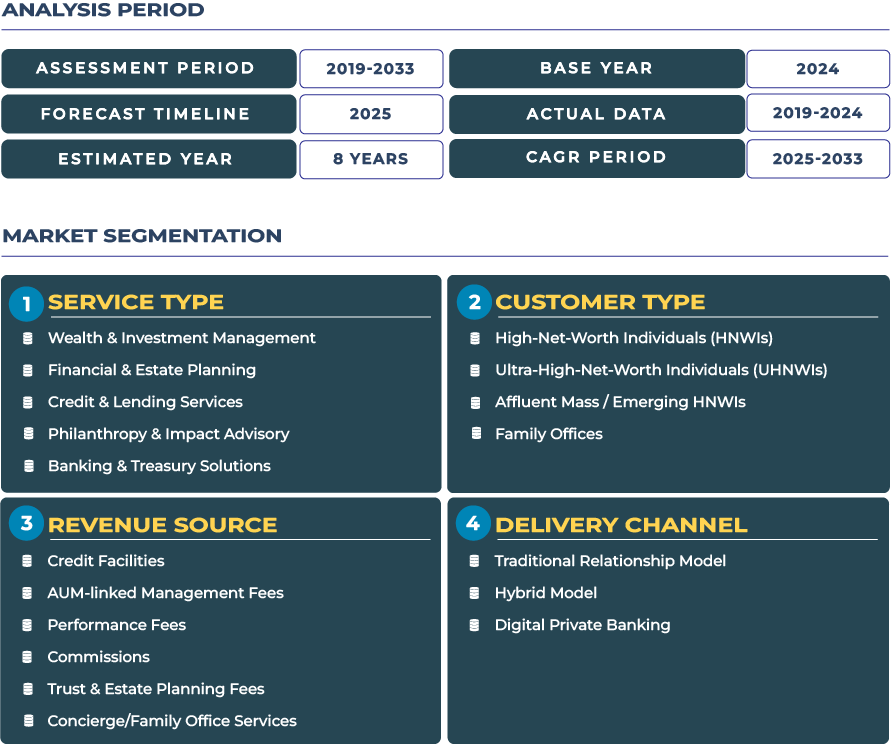Mexico Private Banking Market Outlook: Laying Zero-Foundations for Growth and Innovation in the Private Banking Ecosystem
In a “zero”-based paradigm where every assumption is reassessed, the Mexican private banking market is on the cusp of structural transformation. With a projected rise from approximately USD 19.0 billion in 2025 to around USD 39.8 billion by 2033, representing a CAGR of about 9.7% during the forecast period, this signals not just steady expansion but a strategic rebuilding of the private banking sector. The zero-theme implies that institutions must re-engineer their value chains-moving beyond traditional wealth management to integrated ecosystems tailored for Mexico’s affluent, globally mobile clients.
Note:* The market size refers to the total revenue generated by banks through various services.
For Mexican private banks and wealth platforms, the idle focus around “zero” means shifting from fragmented services to holistic client journeys: from bespoke deposit and lending products to integrated payments, investment services, insurance/bancassurance and treasury-linked offerings. Given Mexico’s evolving geopolitical narratives, currency volatility, pandemic-driven shifts, and U.S./Mexico cross-border dynamics, the private banking landscape must evolve with agility, digital-first frameworks and global connectivity.
Drivers & Restraints: Key Catalysts and Headwinds in Mexico’s Private Banking Sector
Growth drivers. The upward momentum in Mexico’s private banking market is driven by the burgeoning number of high-net-worth and ultra-HNW individuals and business-owner families seeking more sophisticated wealth-management platforms. Mexico is cited among Latin America’s leading markets in terms of HNWI population growth, creating a compelling addressable base. Wealth creation from family businesses, real-estate investment returns, and cross-border linkages with the U.S. are fuelling demand for integrated investment services, liquidity solutions and advisory-led wealth management. Moreover, digital innovation and fintech adoption in Mexico are enabling private banks to extend services into payments, deposits and lending more efficiently shifting the model from advisory only to ecosystem orchestration.
Growth restraints. However, the private banking sector in Mexico is facing key constraints. Currency volatility and macro-economic uncertainty (including inflation and geopolitical spill-over) can suppress risk-taking among affluent clients, thereby limiting asset-flow growth. Regulatory complexity and evolving compliance regimes may slow new product launches or cross-border structuring capabilities. Additionally, the legacy wealth-management framework in many institutions is still product-centric rather than platform-centric, which curtails scalability and margin improvement. Competition from nimble fintech and wealth-tech entrants, combined with high service expectations from affluent clients accustomed to global standards, also places pressure on incumbents to modernise rapidly.
Trends & Opportunities: Digital Wealth, Cross-Border Flows and Regional Affluent Clusters in Mexico
Emerging trends. A significant trend reshaping Mexico’s private banking landscape is digital-wealth transformation. Affluent clients increasingly expect seamless omni-channel platforms that integrate investment services, payments, lending and treasury functionalities. In addition, ESG (environmental, social and governance) priorities are gaining traction-Mexican high-net-worth families are increasingly seeking impact-driven investment structures, sustainability-linked lending and philanthropic-advisory frameworks. Cross-border wealth flows, particularly with the U.S., are also rising, demanding private banks with global advisory capabilities, tax structuring and multi-jurisdictional liquidity solutions.
Opportunity windows. For private banks in Mexico, there is a clear opportunity to differentiate through alternative-investment access (private equity, real estate, venture capital), bespoke credit solutions and treasury optimisation for wealthy clients. Regional hubs such as Mexico City, Monterrey and Guadalajara are maturing in terms of high-net-worth density and entrepreneurial wealth, presenting targeted growth zones. Firms that can embed payments and treasury services into the wealth-management journey-for example, real-time cross-border cash transfers, integrated deposit-to-lending flows and digital wallets for affluent clients-will gain a structural advantage. In addition, Mexican private banks that extend into family-office services, generational wealth transfer advisory and global investment platforms will be aligned to the next wave of market expansion.
Competitive Landscape: Strategic Moves That Are Setting the Pace in Mexico’s Private Banking Market
The competitive terrain in Mexico’s private banking market is intensifying. Leading institutions such as BBVA México continue to expand their digital-wealth footprint, anchor cross-border advisory capabilities and invest significantly in Mexican operations. For example, BBVA announced an investment commitment of approximately USD 5.2 billion in Mexicothrough 2030 to bolster its presence and service offering. At the same time, global banks and wealth-tech entrants are actively targeting wealthy Mexican clients and cross-border flows, driving the need for local players to sharpen segmentation, enhance digital platforms, and partner for alternative-asset access.







